In this fifth and final part of The World of A Dragon among the Eagles, we’re going to take a brief look at a city that has perhaps captured history-lovers’ imaginations more than any other – Alexandria.
There were, of course, many Alexandrias in the world, stretching from Greece to India, but the one we are going to discuss, and which provides the setting for the final third of A Dragon among the Eagles, is Alexandria in Egypt.

Statue of Alexander in downtown Alexandria
Alexandria was founded by Alexander the Great in about 331 B.C., near the westernmost branch of the Nile Delta. From a few scattered fishing villages, it grew to become one of the world’s great metropolises, a centre for trade, religion and learning the world had not really seen to that point.
There are many origin stories to the foundation of Alexandria, but the one I often refer to is that given by Arrian who says the following:
From Memphis he sailed down the river again with his Guards and archers, the Agrianes, and the Royal Cavalry Squadron of the Companions, to Canobus, when he proceeded round Lake Mareotis and finally came ashore at the spot where Alexandria, the city which bears his name, now stands. He was at once struck by the excellence of the site, and convinced that if a city were built upon it, it would prosper. Such was his enthusiasm that he could not wait to begin the work; he himself designed the general layout of the new down, indicating the position of the market square, the number of temples to be built, and what gods they should serve – the gods of Greece and the Egyptian Isis – and the precise limits of its outer defences. He offered sacrifice for a blessing on the work; and the sacrifice proved favourable.
A story is told – and I do not see why one should disbelieve it – that Alexander wished to leave his workmen the plan of the city’s outer defences, but there were no available means of marking out the ground. One of the men, however, had the happy idea of collecting the meal from the soldiers’ packs and sprinkling it on the ground behind the King as he led the way; and it was by this means that Alexander’s design for the outer wall was actually transferred to the ground.
(Arrian; The Campaigns of Alexander, Book III)
There is no real way to know whether this is true or not, but it is not impossible. Alexander was a man of vision, and learned in architecture, planning and much more. As a conqueror of the world, as many saw him, it was to be expected that he create one he hoped would have been a perfect city at the centre of the known world.
The Egyptians had welcomed Alexander as a liberator against the Persians who had disrespected their gods. Alexander, on the other hand, respected Egypt’s ancient gods, and was even declared the son of Zeus Ammon by the famous Oracle at Siwa in the western desert.
Egypt’s new pharaoh had great plans for the city, but he died long before it could be completed. That task fell to Alexander’s friend and general, Ptolemy I, founder of the Ptolemaic dynasty, the last dynasty of Egypt before Rome took over.
Alexandria quickly became a destination that thrived under the Ptolemies, and as the resting place of Alexander the Great’s body, a major tourist destination. It was the greatest of the Hellenistic cities, dwarfing all others.
As time marched on, so did Rome.

Ancient Alexandria in the years after Severus
Alexandria came under Roman jurisdiction in the will of Ptolemy Alexander in 80 B.C. Then, when a domestic dispute broke out between Ptolemy’s children, Ptolemy and Cleopatra, Rome, under Gaius Julius Caesar, stepped in to settle the dispute.
Most of you probably know this part of the story, how Caesar threw his weight behind Cleopatra, making her sole Queen of Egypt in about 47 B.C. They had a son, Caesarion, and the rest is history.
With the death of Caesar, Marcus Antonius and Cleopatra joined forces with the hopes of creating a new, greater Hellenistic world with Alexandria at the centre. But those hopes were dashed by Rome at the Battle of Actium where Octavian came out victorious and as a result, brought Alexandria under the control of Rome.
This is probably one of the most famous periods in Roman history, but it took place two hundred years before A Dragon among the Eagles.
What happened to Alexandria after the Battle of Actium? What did things look like for the city of Alexander?
Even though Rome remained the centre of the Empire, and basically the Mediterranean world, Egypt lost little importance. In fact, it gained, being as it was the granary of the Roman Empire, before the North Africa provinces came to the fore. Alexandria was so important that Octavian kept it under direct imperial control, making it so that Alexandria had no governor, and therefore, no one powerful enough to hold Rome’s grain hostage.
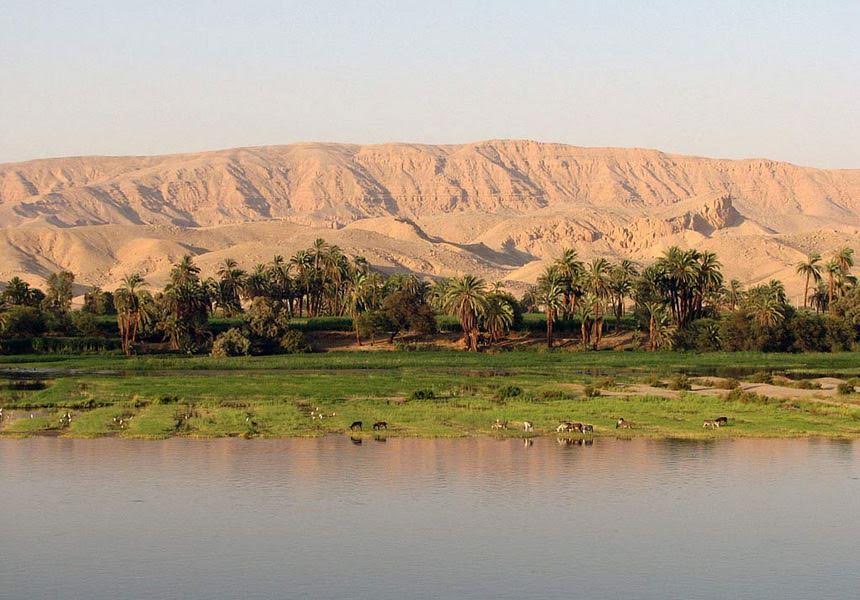
Fertile land of the Nile
Alexandria was beautiful and learned, but it was also tumultuous .
In A.D. 115 it was destroyed during the Greek-Jewish civil war. Luckily, that great phil-Hellene emperor, Hadrian, decided to rebuild the city so that it could continue to thrive.
By the time of A Dragon among the Eagles, when Emperor Septimius Severus and his legions came into Egypt at the conclusion of the Parthian campaign around A.D. 199, Alexandria was once again a metropolis to rival Rome.
Alexandria was always well placed at the crossroads of the world, beside the waters of the Nile Delta, at the edge of the Silk Road, and with free access to the rest of the Mediterranean Sea.
It was built on a narrow strip of land which was sandwiched between the Mediterranean to the north, and the fresh waters of Lake Mareotis to the south.
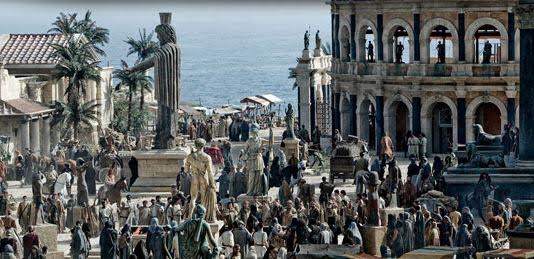
Alexandrian street scene in movie Agora
To the east of the city was the Eleusis Plain which contained an underground complex where the Eleusinian Mysteries, that major ritual of Ancient Greece, were presumably carried out. Closer to the sea on that side of the city were the Jewish and Christian sepulchers, as well as temples and Roman cemeteries beyond the Grove of Nemesis.
On the western side of the city, beyond the Draco River which ran along the south of the city and into the Fluvius Novus, the Great Canal of Alexandria, was the western necropolis which also contained Christian catacombs.
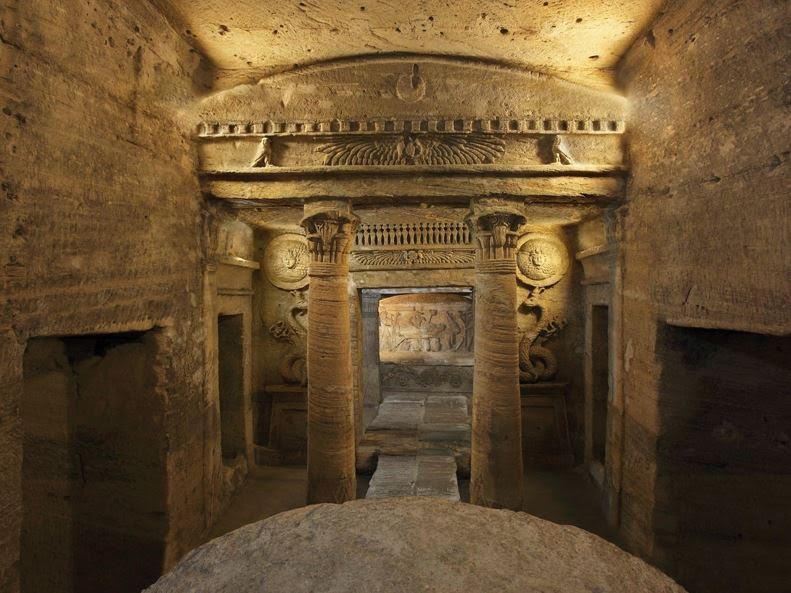
Alexandrian catacombs with mixture of Egyptian, Hellenistic and Roman styles
If you have seen the movie Agora, with Rachel Weiss, you will have seen a later, dirtier recreation of Alexandria from the time of this particular story.
At the heart of Alexandria were the temples and palaces, and the Cema destrict where the tomb of Alexander the Great was located. Through it all ran the great city street known as the Canopic Way.

Alexandria’s Canopic Way (artist impression by Egyptologist Jean-Claude Golvin)
The Canopic Way, with the Sun Gate in the East, and the Moon Gate to the West, was ancient Alexandria’s main artery. It was the place to see and be seen, where giant litters carrying perfumed ladies went back and forth in the shadow of luxurious villas and temples. There were huge fountains running down the middle of the thoroughfare. Perhaps the Canopic Way was a sort of ancient version of Rodeo Drive, or 5th Avenue?
The success and livelihood of Alexandria did not necessarily stem from the richness of the street, nor the number of its temples, but rather from the Great Harbour which was faced by the royal palaces, agora, and the Great Library.
Across the man-made mole known as the Heptastadion, a bridge of about seven stades long, was the island of Pharos, and the structure that beckoned all the world to Alexandria – the Lighthouse.
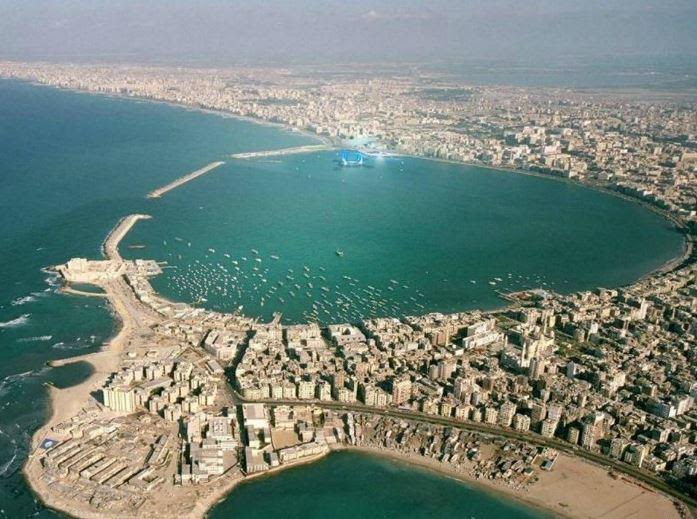
The City of Alexander today
As one of the wonders of the ancient world, the great lighthouse of Alexandria set this city apart, and if that was the beacon, the library, for many, was what awaited them. It has been said that the previous library, that which stood during the reign of Cleopatra, burned down, and all the treasures it contained with it.
However, there are some theories that say the great library was never fully destroyed, that many of the works survived and that the library continued to send people out into the world to collect copies of every book or work ever created.

Library of Alexandria
I wonder if Alexandria would have lived up to the Conqueror’s expectations as he was laying out the city with his men’s rations, prior to his defeat of the Persian Empire?
It is ironic that the body of Alexander also became a big draw in Alexandria, for people came from around the ancient world to see this titan among men.
Augustus himself stopped to see Alexander’s body after the Battle of Actium, and successive emperors did likewise, including Septimius Severus who, for some strange reason, closed Alexander’s tomb to the public prior to going on a Nile cruise with his wife, Julia Domna.
Writing about this ancient city was no easy feat. First of all, I had to discover which structures were actually there during this time, and which I could not include.
It was also fun writing about Alexandria, in comparison to Rome, for it was generally believed that Alexandrian morals were much looser than those of Rome, making it something of a brilliant, seedy, learned metropolis.
When Lucius Metellus Anguis arrives in Alexandria, a city he has dreamed of visiting for a long time, he is torn between two worlds.

Can’t really blame the Emperor and Empress for taking a Nile cruise!
This made for some interesting and fun storytelling.
But it seems to me, after the research I’ve done, and after having written in that world, that Alexandria was anything but uniform, despite its logical grid of streets laid out by Alexander.
Alexandria was a world of contrasts, of perhaps the worst and the best that life had to offer. It preserved culture, and destroyed it, but it always rose from the ashes.

Riotous Alexandrians in the movie Agora
The glory days of its early Hellenistic existence were long gone, but perhaps under Rome, it experienced a revival that may not have been possible under the drunken ancestors of Cleopatra? I’m not sure, but if Cleopatra’s father saw the need to have Rome care for it after his death, there must have been a reason for it.

Antony and Cleopatra

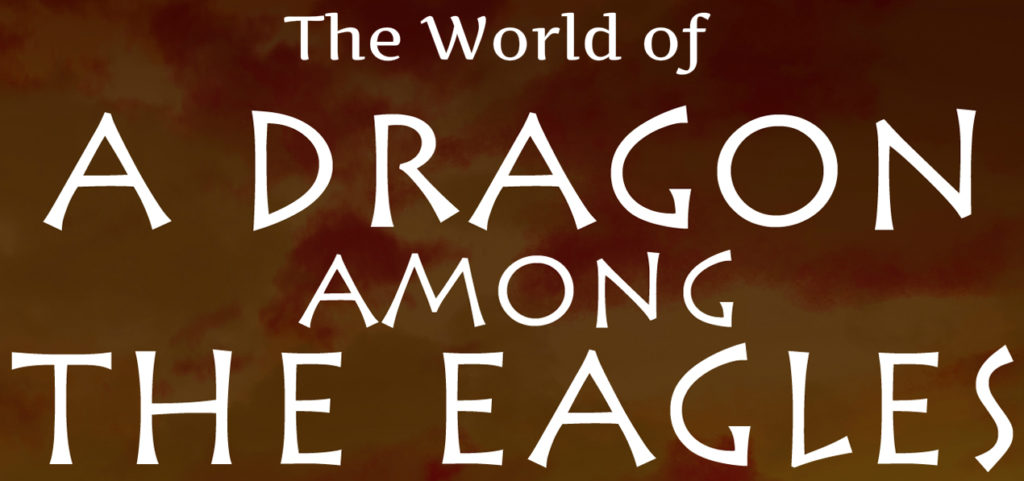
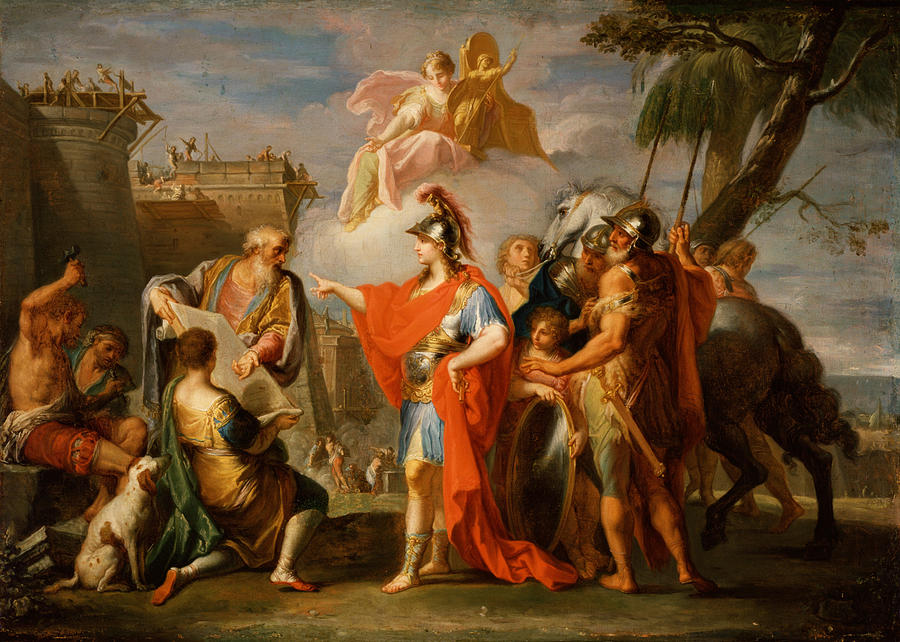
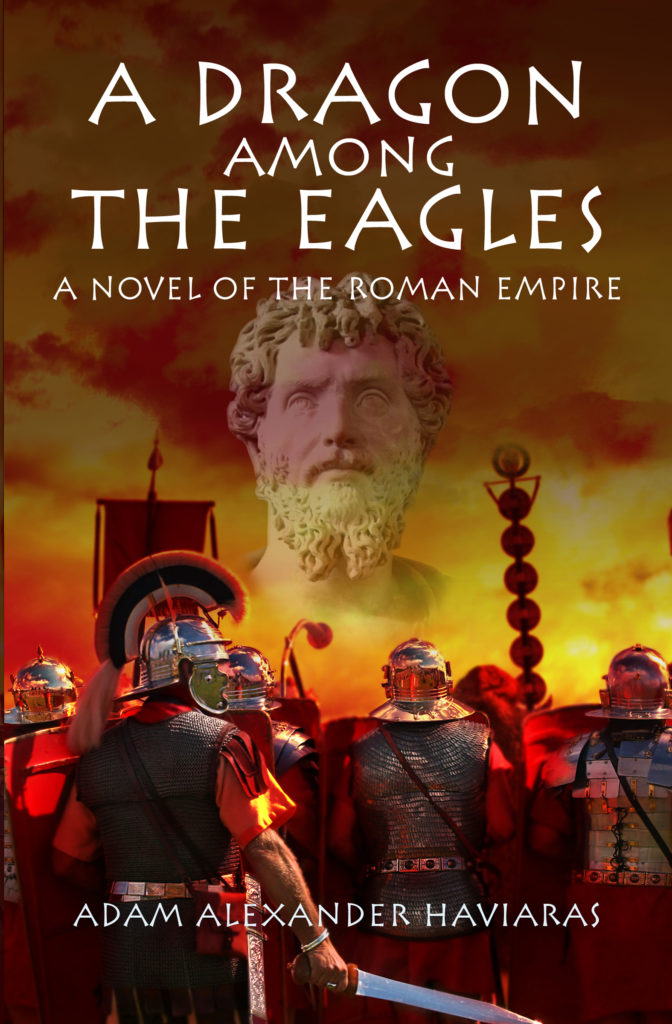
Hi I really enjoyed this and will be referencing it in the Acknowledgements of my next Roman novel. I haven’t read Dragon Among the Eagles yet but checking it out (mostly/entirely reading research at the moment – several hundred years before Hypatia). I hope it did/does everything you hoped for it! All the very best, Peter Tonkin.
Thank you very much for the kind words, Peter. I’m glad you found the post useful, and I hope that you enjoy the novel too. I look forward to your novel on Hypatia – what a fascinating woman of history! Cheers to you! Adam 🙂